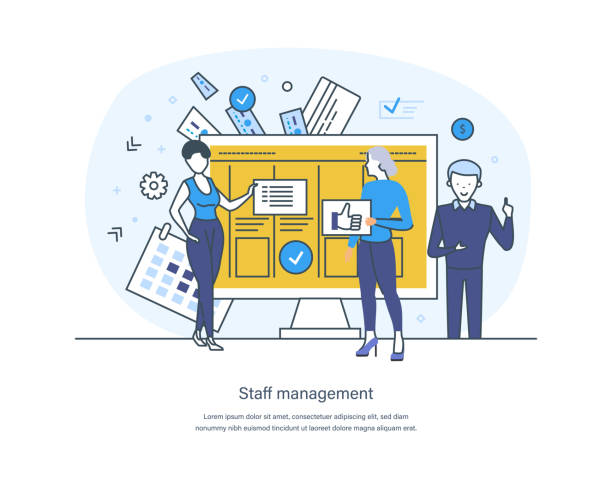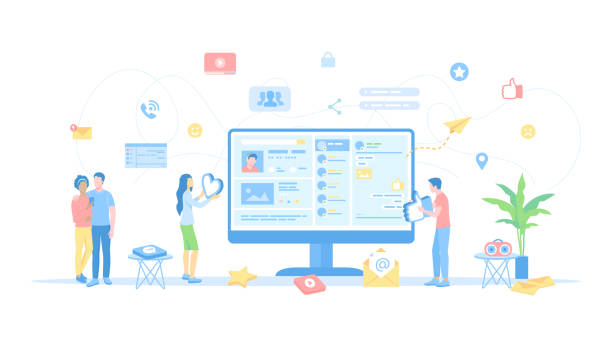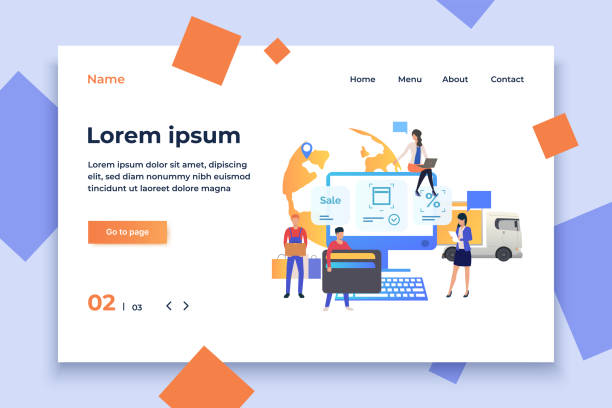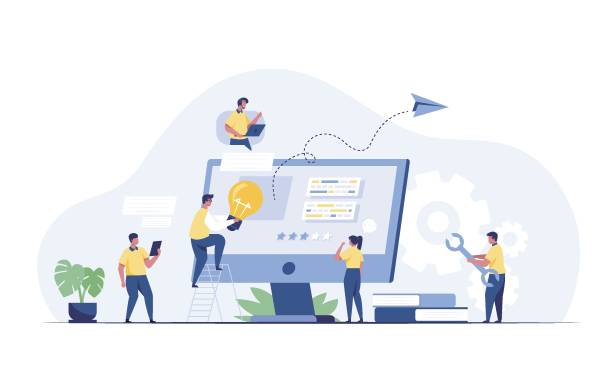Why is Secure Website Design a Vital Necessity?

In today’s digital world, where we witness an unprecedented expansion of businesses and individuals online every day, the concept of #cybersecurity and consequently secure website design has become more important than ever.
Websites are not only the showcase for businesses but also a place for vital interactions, exchange of sensitive information, and financial transactions.
An insecure website can lead to user privacy breaches, theft of confidential information, huge financial losses, and most importantly, loss of #customer_trust.
This issue not only damages a brand’s reputation but can also lead to serious legal consequences for website owners.
The main goal of investing in website security is to protect data, ensure service stability, and maintain credibility in the market. Given the increasing complexity of cyberattacks, from SQL Injection attacks to DDoS attacks, having a comprehensive and preventive approach to secure website design is absolutely essential.
This section explains the importance of this topic and introduces its various aspects.
A #secure_website is the backbone of a successful and reliable online presence.
Are you disappointed with the low conversion rate of your online store?
Rasaweb is your definitive solution with professional e-commerce website design!
✅ Increase your sales and revenue
✅ Unparalleled user experience for your customers
⚡ Get a free consultation now!
Foundational Principles in Website Security

To achieve a truly secure website, foundational security principles must be considered from the very initial stages of design and development. This preventive approach is far more effective and cost-efficient than trying to fix security issues after they arise.
One such principle is “Defense in Depth,” which means using multiple layers of security; so that if one layer is breached, subsequent layers continue to provide protection.
These layers can include Web Application Firewalls (WAFs), Intrusion Detection Systems (IDS), data encryption, and strong authentication.
Another principle is “Least Privilege,” which emphasizes that every user or system should only have access to the minimum resources and permissions necessary to perform their tasks.
This minimizes the risk of privilege misuse.
Also, secure website development requires using secure code and continuous updating of all software components, from the Content Management System (CMS) to plugins and libraries.
Failure to update software is one of the biggest reasons for website vulnerabilities.
This section, in an educational and specialized manner, explains the fundamental importance of these principles in enhancing overall secure website design.
Understanding Common Vulnerabilities and Prevention Methods

Understanding common website vulnerabilities is the first step in combating them.
This section, in an explanatory and guiding manner, introduces some of the most common threats and provides practical prevention methods.
One of the most destructive attacks is SQL Injection, where an attacker gains access to the database by injecting malicious SQL code into application inputs.
To counter it, using Prepared Statements and parameterizing queries is essential.
Cross-Site Scripting (XSS) attacks allow attackers to inject malicious code into users’ browsers.
Careful filtering and validation of user inputs, as well as using Content Security Policy (CSP), can prevent these attacks.
Cross-Site Request Forgery (CSRF) is also an attack where a user is tricked into sending an unwanted request to a legitimate website without their knowledge; CSRF tokens are an effective solution for this type of attack.
Other important issues include vulnerabilities resulting from improper authentication and weak session management.
Secure website design requires special attention to these details.
Table 1: Common Web Vulnerabilities and Countermeasures
| Vulnerability Name | Brief Description | Main Solution |
|---|---|---|
| SQL Injection | Injecting malicious SQL code into the database | Using Prepared Statements |
| Cross-Site Scripting (XSS) | Injecting client-side scripts | Validating and filtering inputs |
| Cross-Site Request Forgery (CSRF) | Executing unwanted requests by the user | Using CSRF tokens |
| Broken Authentication | Weaknesses in authentication mechanisms | Strong passwords, MFA, session management |
The Critical Role of SSL/TLS Certificates in Web Security

One of the most prominent symbols of secure website design is the presence of an SSL/TLS certificate, which encrypts the connection between the user’s browser and the website server.
These certificates, which convert the HTTP protocol to HTTPS, ensure that any information exchanged between the user and the server (such as credit card details, passwords, or personal information) remains confidential and untouched. Without SSL/TLS, information is sent in plain text and is vulnerable to eavesdropping and tampering.
In addition to the security aspect, using HTTPS has significant advantages in SEO (Search Engine Optimization).
Search engines like Google prefer websites with HTTPS in their search results rankings.
This creates an important competitive advantage for websites.
Proper installation and configuration of an SSL/TLS certificate is a fundamental step towards securing a website and is considered a critical specialized and educational element in secure website design.
Also, periodic verification of certificate validity and timely renewal are highly important to prevent security warnings for users.
Is your e-commerce site ready to attract maximum customers and increase sales? Rasaweb transforms your online business with modern and efficient e-commerce website designs.
✅ Increased speed and improved SEO
✅ Excellent user experience on mobile and desktop⚡ Get a free e-commerce website design consultation from Rasaweb now!
Database Security: The Backbone of Every Secure Website

The database is the beating heart of many websites, containing the most valuable information, from user specifications to transaction data.
Therefore, database security plays a pivotal role in maintaining the overall secure website design. One of the most important solutions is to implement strict access controls.
This means that only authorized users and applications with the minimum necessary privileges should be able to access the database.
Using strong usernames and passwords for the database, and changing them periodically, is essential.
Data encryption, both at rest and in transit, is another vital layer of protection.
This makes it difficult or impossible for an attacker to read information even if unauthorized access to the database occurs.
Also, Input Validation for all data entering the database is crucial to prevent attacks like SQL Injection.
Regular and secure backup of the database and storing these backups in a secure, separate location is a guiding and specialized solution that allows for data recovery in case of an attack or disaster, preventing permanent data loss.
Best Practices for Authentication and Access Management

Authentication and access management are the cornerstones of security for any online system and play a vital role in secure website design.
Weakness in this section is a major gateway for attackers to penetrate the system and access confidential information. The first step is to encourage users to use strong and unique passwords.
This can be achieved by implementing password complexity policies (a combination of uppercase and lowercase letters, numbers, and special characters) and prohibiting the use of common and leaked passwords.
But a password alone is not enough.
Multi-Factor Authentication (MFA) adds a powerful security layer, making unauthorized access difficult even if the password is leaked.
Proper management of user sessions is also highly important; ensuring session expiration after a period of inactivity and using secure session tokens prevents session hijacking.
Finally, implementing Role-Based Access Control (RBAC), which grants each user only the necessary access to perform their task, is a fundamental educational and explanatory principle in secure website design and efficient access management in large systems.
The Importance of Regular Security Audits and Penetration Testing

Even with the best practices in secure website design, cyber threats are constantly evolving. Therefore, websites must be regularly subjected to rigorous security checks.
Security Audits involve reviewing code, server configurations, and security protocols to identify potential weaknesses.
These audits can be performed internally or by specialized third-party companies.
The results of these audits provide a comprehensive analytical view of the website’s security status and help the development team identify priorities for improvement.
In addition to audits, Penetration Testing is a proactive and informative method in which security experts (Pentesters) simulate real attacks to discover vulnerabilities before actual attackers.
These tests involve attempting to bypass security systems, exploiting known weaknesses, and even finding unknown vulnerabilities (Zero-day vulnerabilities).
A secure website is a site that is constantly tested.
This approach helps websites remain resilient against the latest threats and ensures a continuous routine for improving secure website design.
Table 2: Common Web Auditing and Penetration Testing Tools
| Tool Name | Type | Primary Use |
|---|---|---|
| Nmap | Network scanner | Discovering open ports and services |
| OWASP ZAP | Web vulnerability scanner | Identifying web vulnerabilities (XSS, SQLi) |
| Burp Suite | Proxy and web penetration tool | Manual web vulnerability testing |
| Metasploit | Penetration testing framework | Exploiting vulnerabilities |
Planning for Incident Response and Disaster Recovery

Even with the best provisions in secure website design, no website is 100% immune to attacks. Therefore, having a comprehensive plan for Incident Response and Disaster Recovery is of paramount importance.
These plans help websites minimize damage and quickly return to normal operation in the event of a security breach or any serious disruption.
An incident response plan should include specific steps for identification, containment, eradication, recovery, and post-incident analysis.
This plan should clearly define the responsibilities of each individual and team and specify internal and external communication channels. For example, in the event of data theft, who should inform users and which authorities should be contacted? From a guiding and specialized perspective, the disaster recovery section focuses on ensuring access to up-to-date and recoverable backups.
Regular backups of all website data and code and storing them in secure locations, separate from the main system, are crucial.
These plans ensure that even in the worst-case scenarios, the website will be able to return to its normal operations and user trust will be maintained.
Are you disappointed with the low conversion rate of your online store?
Rasaweb is your definitive solution with professional e-commerce website design!
✅ Increase your sales and revenue
✅ Unparalleled user experience for your customers
⚡ Get a free consultation now!
Future Trends in Web Security and Upcoming Challenges

The world of cybersecurity is dynamic, and we witness the emergence of new threats and technologies every day.
This section, in an analytical and thought-provoking manner, examines future trends and the challenges that secure website design will face.
One of the most important trends is the use of Artificial Intelligence (AI) and Machine Learning (ML) in both defense and attack. Attackers use AI to make their attacks more sophisticated, while defenders use it to detect suspicious patterns and predict threats.
The emergence of blockchain technology can also have a significant impact on web security, especially in decentralized authentication and identity management.
Also, security architectures like Zero Trust, which are based on the principle of “never trust, always verify,” are becoming widespread.
These architectures assume that no network or user is trustworthy by default, and every request must be verified.
New challenges such as IoT security and more sophisticated phishing attacks also emphasize the importance of a proactive approach in secure website design. Understanding these trends is essential for maintaining website security in the future.
Continuous Security: The Key to Success in the Digital World

Ultimately, it must be emphasized that secure website design is not a one-time process, but a continuous and cyclical effort. Given the rapid changes in information technology and cyber threats, every website requires continuous maintenance, monitoring, and updates from a security perspective.
This explanatory and guiding section provides a summary of the website security journey and the importance of its continuity.
From implementing SSL/TLS certificates and strong encryption to rigorous input validation, proper database management, and multi-factor authentication, each of these steps is essential for creating a secure website design.
But these efforts must be complemented by regular security audits, penetration testing, and meticulous incident response planning.
Security awareness among employees and users is also a crucial element, as many attacks occur through human deception.
By accepting the reality that security is an endless journey and continuously investing in it, websites can remain resilient against the evolving threat landscape and maintain user trust.
This continuity in securing is the key to success for a brilliant and stable digital presence.
Frequently Asked Questions
| Question | Answer |
|---|---|
| What is secure website design? | Secure website design is a process where websites are built with security principles in mind to be resilient against cyberattacks and to protect user and business information. |
| Why is secure website design highly important? | To prevent unauthorized data access, sensitive information leaks, malware attacks, loss of user trust, damage to business reputation, and legal consequences arising from data breaches. |
| What are the most common website vulnerabilities? | SQL Injection, Cross-Site Scripting (XSS), Cross-Site Request Forgery (CSRF), broken authentication and session management, and sensitive data exposure. |
| How can SQL Injection attacks be prevented? | Using Prepared Statements with parameterized queries, Input Validation, and limiting database access. |
| What are the methods to counter XSS (Cross-Site Scripting) attacks? | User Input Validation, Output Encoding before display in HTML, and using Content Security Policy (CSP). |
| What is the role of HTTPS in website security? | HTTPS encrypts the communication between the user’s browser and the website server using an SSL/TLS certificate, preventing eavesdropping, tampering, or forgery of data. |
| What are the best practices for user password management? | Enforcing strong passwords (a combination of letters, numbers, and symbols), hashing passwords instead of direct storage (with strong algorithms like bcrypt), and enabling Two-Factor Authentication (2FA). |
| What is the importance of User Input Validation? | Input validation prevents malicious or unexpected data from entering the system, which can lead to vulnerabilities such as SQL Injection or XSS. |
| What is the impact of regular security checks and audits on site security? | These checks help in early identification of security vulnerabilities and weaknesses, allowing them to be addressed before they can be exploited. |
| Web Application Firewall (WAF) what is its application in secure website design? | A WAF acts as a protective layer between the user and the website, analyzing incoming traffic, and identifying and blocking common web attacks like SQL Injection and XSS. |
And other services by Rasaweb Advertising Agency in the field of advertising
Smart Google Ads: An effective tool to improve SEO ranking with the help of SEO-centric content strategy.
Smart Advertising Campaign: Professional optimization to increase website traffic using user experience customization.
Smart Brand Identity: A professional solution for campaign management focusing on SEO-centric content strategy.
Smart Google Ads: A professional solution for improving SEO ranking with a focus on marketing automation.
Smart Website Development: An innovative platform for improving user engagement with marketing automation.
And over a hundred other services in internet advertising, advertising consultation, and organizational solutions
Internet Advertising | Advertising Strategy | Advertorials
Resources
Important tips for increasing site security
Website Security Checklist
Web security on Wikipedia
What is website security?
? With Rasaweb Afarin, the digital future of your business is in our hands. We guarantee a powerful and impactful online presence for you by providing comprehensive services in SEO, content marketing, and multilingual website design.
📍 Tehran, Mirdamad Street, next to Central Bank, Kazeroon Janubi Alley, Ramin Alley, No. 6



